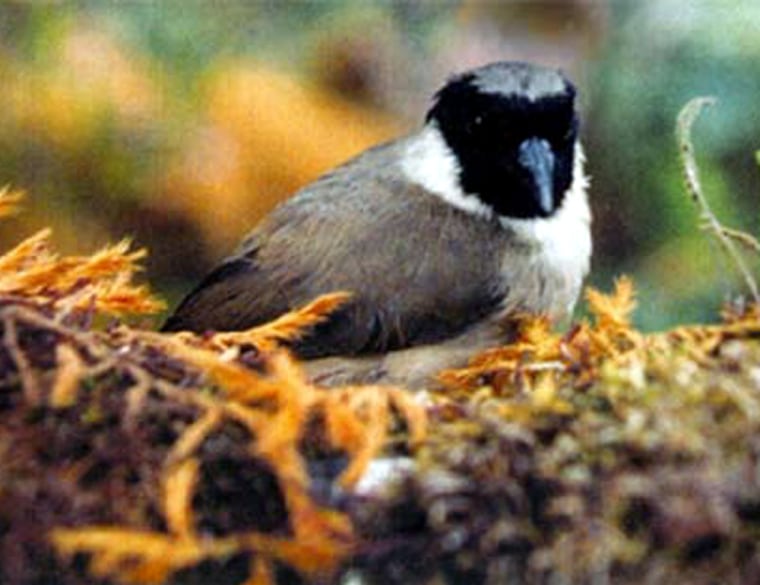Where's the nation's most threatened bird habitat? The American Bird Conservancy came up with its list, and sitting on top is a place most Americans would consider idyllic: Hawaii's forests.
In a new report by the group, Hawaiian forests were listed ahead of the open ocean and sea bird nesting islands, which ranked second and also includes Hawaii territory. Third on the list was sagebrush areas found in Western states such as Washington, Oregon and Montana. And fourth was the Edwards Plateau Savannah of Texas.
"Saving these species is important but meaningless if the habitats they come from are also not protected," said Alan Lieberman, director of the Hawaiian Endangered Bird Conservation Program for the San Diego Zoo.
The tropical chain of Hawaiian islands isolated in the middle of the Pacific Ocean was home to about 140 native breeding species and subspecies before the arrival of humans in the archipelago. More than half of the bird species are now extinct. And among the 71 remaining Hawaiian birds, 30 are listed as endangered or threatened under the federal Endangered Species Act, according to the state's Department of Natural Resources' Web site.
The threat to birds' habitat in Hawaii — from avian diseases, invasive plants and invasive species such as cats — continues despite the efforts of government agencies and private organizations like the San Diego Zoo, the report said.
Breeding programs help
Still there's some cause for hope.
The zoo's bird program has centers on Maui and the Big Island that have been breeding seven endangered species of Hawaiian birds. And in August the program plans to release its last Hawaii creepers and Hawaii akepas on the slopes of Mauna Kea. That's because state and federal authorities are now managing the two species' habitat well enough that propagation of the birds is no longer needed, Lieberman said.
"Yes, we do know that we have the dubious distinction as the endangered species capital of the world. But that is something that has been developed over a long time, and we are working on a variety of things," said Peter Young, state Department of Land and Natural Resources chairman.
Those efforts include partnerships with private landowners to conserve habitat; a system of natural area reserves; projects to fence off areas from invasive species, such as goats, that destroy native plants, and a recovery plan for forest birds.
Activists want federal money
It isn't that government agencies aren't doing what they should about saving habitats and birds, but more money is needed to make those efforts a success, said Michael Parr, vice president of the Washington-based American Bird Conservancy.
"What we really need to see is significant new funding for Hawaiian forest birds at the federal level to get this plan implemented. There is some money, but we need to take it up several notches," he said.
Success is possible but the key to helping Hawaii's birds is keeping expectations realistic, such as rehabilitating highland areas where some habitats are still intact, Lieberman said.
"I don't think anyone is so naive as to think they're going to turn Waikiki into the wetland that it once was," he said.
Ultimately, the message is more one of hope rather than despair, Young said.
"There's a lot of people doing a lot of good things to make sure that history doesn't repeat itself and that we actually do have a recovery of species rather than another one added to the list or another one off the list because it's gone to extinction," he said.
Other areas on the list
The conservation group listed 20 threatened areas in all. The rest were:
5. Southwest Riparian (AZ, NM, CA, NV, and TX)
6. Tallgrass Prairies (IL, IN, OH, MO, KS, and IA)
7. Coastal Beaches and Marshes ( U.S. coastline)
8. Gulf Coast Prairie (LA and TX)
9. Lake Wales Oak Ridge Scrub ( Central Florida)
10. Mixed Longleaf Pine/Bottomland Hardwood Forest (NC, SC, GA, FL, MS, and AL)
11. Great Plains Wetlands (MN, ND, SD, NE)
12. California’s Central Valley (CA)
13. Florida Wetlands (FL)
14. Chaparral (CA)
15. Shortgrass Prairie (KS, NE, CO, OK, TX, and NM)
16. Bottomland Hardwood Forest (LA, AR, MS, and TN)
17. Ponderosa Pine (MT, ID, OR, and WA)
18. Oak Savannah (OR, WA, and CA)
19. Early Successional/Eastern Deciduous Forests (eastern states)
20. Northwest Rainforest (AK, BC, OR, WA, and CA)
